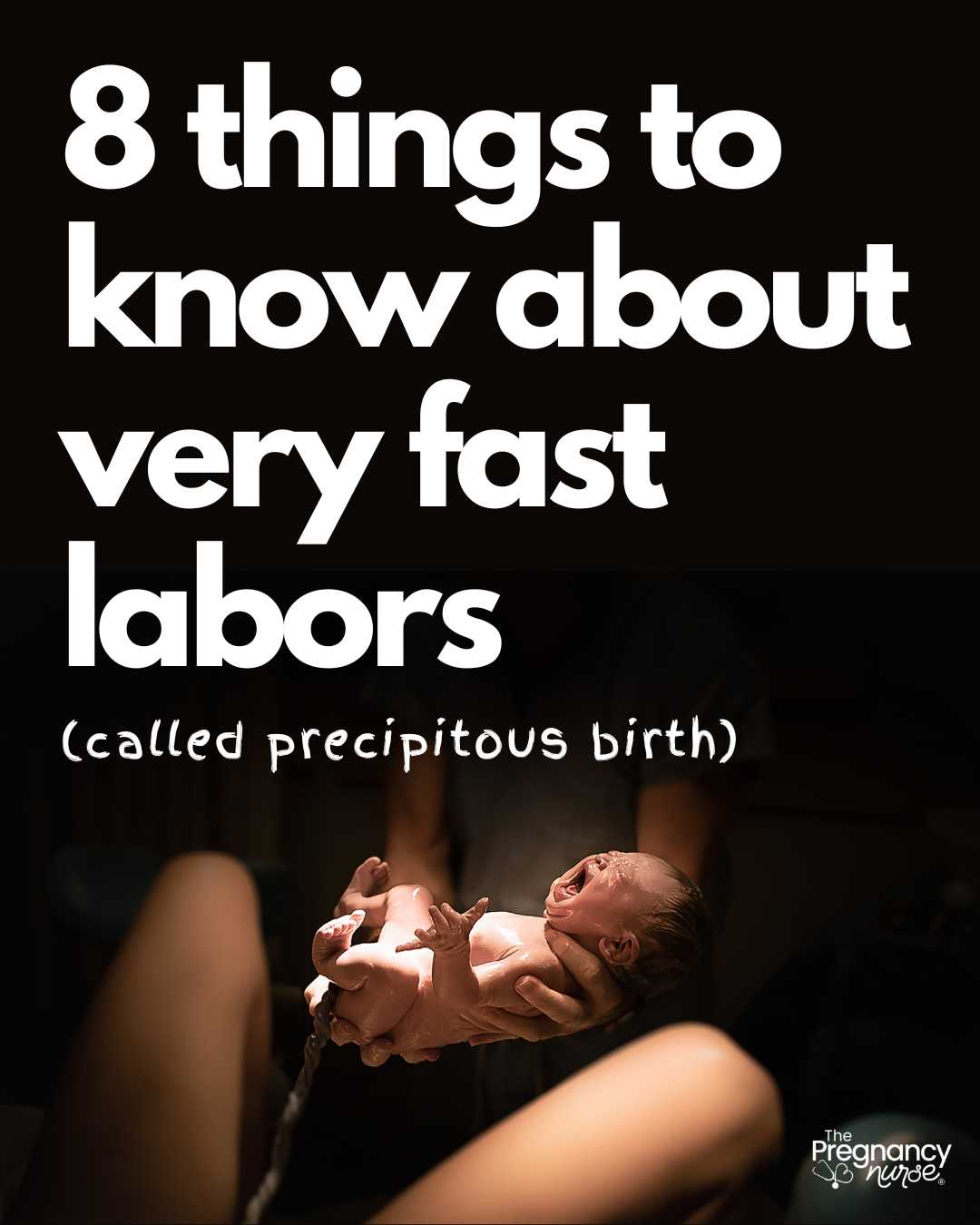Precipitous labor is considered birth within 3 hours of contractions becoming regular. It can be really intense, fast and scary for those who experience it. Here are eight things to know in case it happens to you.
If you’ve had a fast labor, it’s likely you will have a fast labor again, so I hope these tips help you out! BUT keep in mind this only happens in about 3% of births.
It Tends to Be The Safest
This is the fact that kept me from dying as a new labor and delivery nurse who had to deliver a baby on her own every now and then.
When baby comes this fast, it most often means that everything is aligned well and baby is going to come out easily. This study from the NIH shows that it is not associated with poor outcomes.
SO, reminding yourself that your body was meant to do this and everything is lined up JUST RIGHT can help you chill out, I find.
The reality is that most births don’t actually need medical help. We’re mostly there “just in case” — and this tends to be one of those times too!
Fun Fact: The average time for labor (not an induction, but actual labor) is 6-18 hours according to the American Pregnancy Association).
Learning about the stages of labor can help a LOT whether you have a fast labor, or a slow one — this goes over them and helps you know what to expect so anxiety isn’t in the front seat of your birth.
It Can Be a Reason to Be Induced
If you’ve had a very fast labor in the past it can be a reason to be induced with your next baby to make sure that you’re in the hospital.
Check out my posts on the other reasons for induction.
So. Many. Fluids
Guys, there is SO many bodily fluids involved in labor. Like, so. much. So I always recommend that people have some towels at work and in your car (and obviously at home), but if you really want to be prepared, I would 100% buy these or these (affiliate links). I think if you don’t use them in labor you’ll use them to cover your couch when the little on is sick later on.
I just think that it could be something that saves your car, your carpet, or your bed just in case. 🙂 It’s also great for water breaking!
When to Go to The Hospital?
Honestly most often these are the people who are having birth happen like it does in the movies.
They start having contractions, they’re immediately very regular and very painful. It tends to be VERY clear it’s time to go to the hospital ASAP.
(that – bytheway, is not the norm)
It’s SUPER important to talk with your provider about when you should go to the hospital. I see a lot of people saying they have the “golden rule” about when you should head in — but honestly it varies so much. I have a whole post on how to time going to the hospital but it needs to be a discussion with your provider.
That’s why I’m a BIG fan of learning the basics, so you can have more in-depth discussions with your provider about what they expect for your birth and what you need to know.
And while you’re here, grab my labor signs checklist:
Don’t Panic
This is SO much easier said than done. But like I mentioned in #1 — this often means mother nature is doing a REALLY great job with your birth.
Obviously, get into your provider asap, but you have to just let your body do what it’s going to do (and let your transporter do what they need to do). Most often people make it to the hospital, and onto a bed. We can get them out of their clothes and deliver baby when you’re ready.
Honestly, sometimes we’re even able to get you an epidural (but this is one of the reasons I think everyone needs some natural pain management and I recommend this class).
The main issue is when you panic and start to hyperventilate or have so many stress hormones gushing through your system that affect both you and baby. So, the more calm you can be the better it will be for both of you.
You just have to take it one step at a time. Let the people around you know what you need. Don’t try to predict the future of what baby will or won’t do and remain calm as much as possible.
I will say that the idea of a precipitous birth seems so scary, but a 3-hour birth is one of my favorites. An hour to get your stuff together and drive to the hospital, an hour to admit you, maybe get an epidural, and then let’s have a baby!
BTW having the NECESSITIES in a hospital bag isn’t a bad idea — grab my packing list here:
Get Therapy
This is for the moms who’ve previously had a precipitous birth and are so scared about the next birth.
I hear a lot of birth stories, but if you’ve previously had a precipitous birth that scared the heck out of you, I think therapy isn’t a bad idea. See if your provider has anyone that they recommend.
Processing how that happened, and how everyone is safe can help you feel more comfortable on this birth.
It can seem like “overkill” but I can vouch for the fact that it is NOT and you’re going to have a lot more relaxed pregnancy and birth by getting some help from a professional. I bet you’ll only need a few sessions and you’ll feel a lot better and also have some coping skills when that anxiety rears its ugly head again.
Also, if it happens to you talk with your birth team about your fears and what you felt. They can often help explain what went on to stop all those crazy thoughts in their tracks. We want you to feel comfortable and not terrorized by what went on, so keep the conversation going.
Honestly, previous birth trauma is one of the big reasons I recommend getting a birth class on a second+ birth. Knowing more about birth, what your body does and what your options are can help a lot, even if it’s not your first. I recommend The Online Prenatal Class for Couples.
Check On Your Partner
I should say that while this can be very scary for the person giving birth, it can be just as scary for the partner. They often haven’t been prepared for birth in general, and then the concern of being “help” in case baby is born can be really hard.
Which is why I recommend a prenatal class for couples. The more they know about birth, the more confident they’re going to feel no matter what your birth looks like.
Looking to get prepare for your birth? I have some easy options for you!
~~~~~~~~
– Worried you’re missing something? Grab my pregnancy planner so you don’t miss a thing!
– Thinking about an induction? Grab Inductions Made Easy to feel prepared in just 20 minutes!
– Wondering how to get that baby OUT? Grab Going Into Labor Made Easy so you know how to (and not to) do it!
– Postpartum got you anxious? Check out Postpartum Care Made Easy so you can stay SAFE even when all your attention is on that little on.
🚨 AND if ALL OF IT has got you on edge The Online Prenatal Class for Couples is perfect for you — You’ll feel so ready before you even know it!
~~~~~~~~
No matter WHERE you are at in your pregnancy journey, we have resources that can help!
What to do?
Disclosure: I am definitely NOT a pro at delivering at home, but I do know how to deliver a baby in a pinch, so this is just general advice. If you really are concerned, ask your provider if they have resources… this is the VERY BASICS. You need to call 911 to get medical help ASAP.
Ok, your provider may have a pamphlet on what to do if you deliver at home, and I bet there’s a lot of great resources online…. but first, call 911 (or your emergency system) if you think you’re giving birth right away. The 911 operator can walk you and your partner through it.
But ultimately if the head emerges, you apply a little traction (pull a little) downwards, release one shoulder from under the pubic bone, and then you pull up to release the other shoulder. Be sure to have some warm linens (even dad’s shirt) to put baby on because baby being cold is a big issue.
Dry baby off as well as you can (including wiping off their mouth and nose area). Rub their back and feet until they start crying, and then put baby skin to skin with someone (usually mom but if she’s a mess the body heat of anyone is enough). Make sure baby is getting more pink and stays warm.
It’s normal for baby’s hands/feet to stay blue-ish for the first hour or so. Make sure you’re looking at their face/trunk as you check to make sure they’re pink.
You don’t need to worry about the cord, it will shut off on it’s own now that it’s exposed to air. Hopefully a medical team is on their way to help you out. 🙂 They can do that job.
When you read that, you may think — gosh Hilary, that’s pretty simple — and I agree. Birth can be really simple. And now you know what to do if you get in that spot. Just make SURE that you have medical help on the way. There can be complications and you may need their help.
Most people are then transported to their birth facility where a provider checks them out, sees if they tore and baby is checked out to make sure they’re OK.
So, there you go — that’s fast birth. I hope you found that helpful. But remember, that really happens VERY rarely. So, get prepared for ALL of birth in The Online Prenatal Class for Couples — in just a few hours you can feel so much more confident and prepared no matter what birth brings at you.
Want to do a vibe check before diving into the whole thing with me? — check out my free labor pro tips. It’s your first step toward getting in the driver’s seat of your birth.
Sources:
- Length of Labor: https://americanpregnancy.org/healthy-pregnancy/labor-and-birth/rapid-labor/
- Outcomes from Precipitous Labor: https://www.ncbi.nlm.nih.gov/pmc/articles/PMC4285060/












 The BIGGEST Myth About Labor (bar-none)
The BIGGEST Myth About Labor (bar-none)
